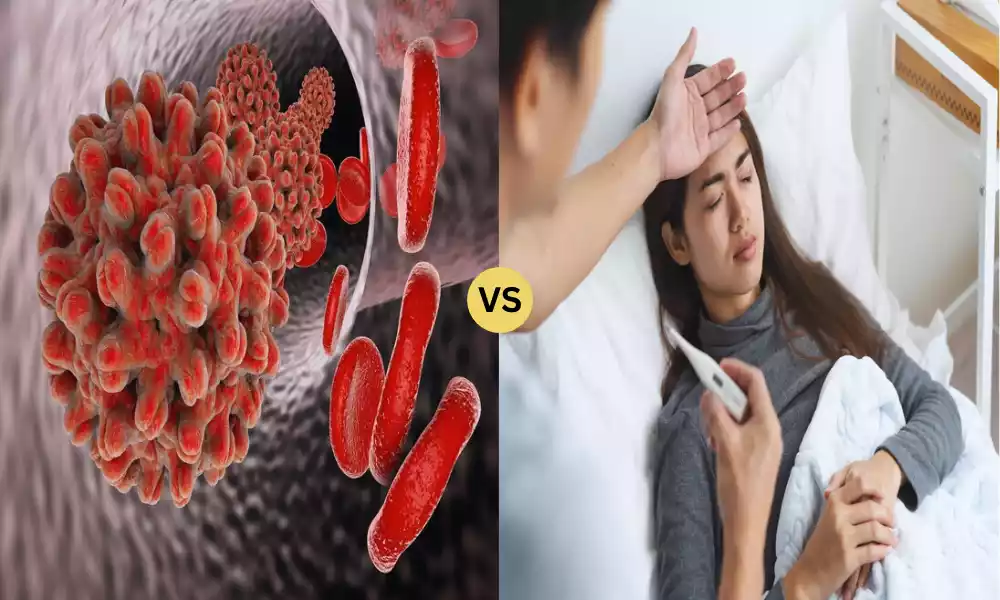Typhoid and Viral Fever are two distinct infectious diseases that can cause fever and various symptoms. Typhoid Fever is primarily caused by the Salmonella Typhi bacteria and is transmitted through contaminated food and water, while Viral Fever encompasses a range of febrile illnesses caused by different viruses, including influenza and dengue. These illnesses differ in their causes, symptoms, diagnostic methods, and treatments, making it crucial to differentiate between them for accurate diagnosis and effective management. This content explores the key differences between Typhoid and Viral Fever, providing insights into their causes, symptoms, diagnosis, and prevention strategies.
Typhoid Fever
Typhoid fever is a systemic and potentially life-threatening infectious disease caused by the bacterium Salmonella Typhi. It is characterized by a sustained high fever, abdominal pain, and various gastrointestinal symptoms such as diarrhea or constipation. This illness is typically contracted through the ingestion of contaminated food or water containing the Salmonella Typhi bacteria. Once inside the body, the bacteria can spread to the bloodstream and other organs, leading to a systemic infection.

Typhoid fever can have serious complications if left untreated, including intestinal perforation and septicemia. Diagnosis involves blood cultures and specific antibody tests, and treatment typically includes antibiotics and supportive care. Vaccination and sanitation measures are essential for preventing typhoid fever, especially in regions where the disease is endemic.
Causes of Typhoid Fever
Typhoid fever is primarily caused by the bacterium Salmonella enterica serotype Typhi, specifically the strain Salmonella Typhi. This bacterium is responsible for the infection and the characteristic symptoms of typhoid fever. The primary mode of transmission is through the ingestion of food or water contaminated with the feces or urine of an infected person.
Here are the key causes and factors contributing to the development of typhoid fever:
-
- Salmonella Typhi Bacteria: This bacterium is the causative agent of typhoid fever. It is highly adapted to the human digestive system and can survive in the environment for extended periods.
- Fecal-Oral Transmission: Typhoid fever is mainly spread through the fecal-oral route. Contaminated food and water are the most common sources of transmission. Poor sanitation, improper sewage disposal, and contaminated drinking water are significant factors in the spread of the disease.
- Infected Individuals: People who are carriers of Salmonella Typhi but do not display symptoms of the disease (asymptomatic carriers) can unknowingly transmit the bacteria to others. These carriers may continue to shed the bacteria in their feces or urine for an extended period.
- Contaminated Food: Consumption of food prepared by an infected person who did not practice proper hygiene, or food that has been exposed to contaminated water or surfaces, can introduce the bacteria into the body.
- Contaminated Water: Drinking water from a source contaminated with Salmonella Typhi is a common mode of transmission. This can occur through the contamination of water supplies, wells, or water storage containers.
- Poor Sanitation: In areas with inadequate sanitation facilities and practices, there is a higher risk of fecal contamination of the environment, leading to a greater chance of transmission.
- Close Contact: Close contact with an infected individual, especially in crowded or unsanitary conditions, can facilitate the spread of the bacteria.
- Travel to Endemic Areas: Traveling to regions with a higher prevalence of typhoid fever increases the risk of exposure to contaminated food and water sources.
- Contaminated Objects: In rare cases, typhoid bacteria can be transmitted through contact with objects (fomites) contaminated with the bacteria, although this is less common than food and waterborne transmission.
- Immune System Susceptibility: Individuals with weakened immune systems, such as those with HIV/AIDS or other immunocompromising conditions, may be more susceptible to developing severe cases of typhoid fever.
Preventing typhoid fever involves measures such as vaccination, practicing good personal hygiene, ensuring access to clean drinking water, maintaining proper sanitation, and being cautious about food safety, especially when traveling to areas with a higher risk of the disease. If typhoid fever is suspected, prompt diagnosis and appropriate antibiotic treatment are essential to prevent complications and further transmission of the disease.
Symptoms of Typhoid Fever
Typhoid fever is characterized by a range of symptoms that typically develop gradually and can vary in severity. The symptoms of typhoid fever can be mistaken for other illnesses, so it’s important to consult a healthcare professional for an accurate diagnosis if you suspect you or someone you know may have typhoid fever.
Common symptoms of typhoid fever include:
-
- High Fever: One of the hallmark symptoms of typhoid fever is a persistent and high fever that can reach temperatures of 103-104°F (39-40°C). This fever may gradually increase over several days.
- Headache: Many individuals with typhoid fever experience a severe headache, often described as throbbing or pounding.
- Abdominal Pain: Abdominal discomfort or pain is common and can range from mild to severe. It is often located in the area around the navel.
- Weakness and Fatigue: Typhoid fever can cause extreme tiredness and weakness, which can interfere with daily activities.
- Loss of Appetite: Individuals with typhoid fever often lose their appetite and may have a reduced interest in food.
- Gastrointestinal Symptoms: These can include diarrhea or constipation, as well as nausea and vomiting.
- Rose Spots: In some cases, small, pink, or rose-colored spots may appear on the trunk and abdomen of the body. These spots are a characteristic but not universal feature of typhoid fever.
- Cough: A persistent cough can develop in some cases, especially if the infection spreads to the lungs.
- Spleen and Liver Enlargement: The spleen and liver may become enlarged during the course of the illness, leading to discomfort in the upper abdomen.
- Bradyarrhythmia: Rarely, typhoid fever can affect the heart’s electrical system, leading to a slow heart rate (bradycardia).
- Confusion or Delirium: In severe cases or if left untreated, typhoid fever can lead to mental confusion or delirium.
- Complications: Without treatment, typhoid fever can lead to serious complications, including intestinal perforation, septicemia (bloodstream infection), and organ failure.
The symptoms of typhoid fever can mimic those of other illnesses, such as malaria, dengue fever, or various gastrointestinal infections. Proper diagnosis often requires laboratory tests, including blood cultures and the Widal test, which detects specific antibodies to Salmonella Typhi.
Viral Fever
Viral fever is a general term used to describe an elevated body temperature (fever) that is primarily caused by an infection with a virus. It is a common symptom of many viral infections and can be accompanied by a range of other symptoms, depending on the specific virus involved. Viral fevers can manifest as a part of illnesses like the common cold, influenza (the flu), dengue fever, or various other viral infections.

These fevers are typically characterized by sudden onset, a variable degree of fever, and may be accompanied by symptoms such as cough, sore throat, body aches, headache, fatigue, and in some cases, a rash. Treatment for viral fever often involves managing the symptoms with rest, hydration, and over-the-counter medications to alleviate discomfort. In some cases, antiviral medications may be prescribed for specific viral infections. It’s important to note that antibiotics are not effective against viral infections, so treatment primarily focuses on supportive care and addressing the underlying viral illness.
Causes of Viral Fever
Viral fever, also known as fever due to a viral infection, can be caused by a wide variety of viruses. These viruses enter the body and trigger the immune system’s response, which often includes an increase in body temperature (fever) as the body tries to fight off the infection.
Common causes of viral fever include:
-
- Influenza (Flu) Viruses: Influenza viruses, including influenza A, B, and C, are known to cause seasonal flu outbreaks with symptoms that often include fever, chills, sore throat, cough, and body aches.
- Rhinoviruses: These are the most common cause of the common cold, which can lead to a mild viral fever along with symptoms such as a runny or stuffy nose, sneezing, and a sore throat.
- Coronavirus: Certain strains of coronaviruses, like SARS-CoV-2 (the virus responsible for COVID-19), can cause fever along with respiratory symptoms and other complications.
- Dengue Virus: Dengue fever is transmitted by Aedes mosquitoes and can lead to a high fever, severe headache, joint and muscle pain, and in severe cases, dengue hemorrhagic fever or dengue shock syndrome.
- Zika Virus: Zika virus infection may cause fever, rash, joint pain, and conjunctivitis. It can be transmitted by mosquitoes or through sexual contact.
- Epstein-Barr Virus (EBV): This virus is associated with infectious mononucleosis (mono) and can cause fever, sore throat, swollen lymph nodes, and fatigue.
- Herpesviruses: Several herpesviruses, such as herpes simplex virus (HSV) and varicella-zoster virus (VZV), can cause fever during primary infections or reactivations, leading to conditions like cold sores, chickenpox, or shingles.
- Enteroviruses: Enteroviruses, like coxsackievirus and echovirus, can cause fever and various symptoms, including hand, foot, and mouth disease or viral meningitis.
- Cytomegalovirus (CMV): CMV infections can lead to fever and symptoms in immunocompromised individuals, such as those with HIV/AIDS or organ transplant recipients.
- Hepatitis Viruses: Certain hepatitis viruses (e.g., hepatitis A, B, and C) can cause fever, jaundice, and liver-related symptoms during infection.
- Yellow Fever Virus: Yellow fever, transmitted by Aedes mosquitoes in certain regions, can lead to a high fever, jaundice, and severe illness.
There are many other viruses that can cause febrile illnesses, and the specific symptoms and severity can vary widely depending on the virus and the individual’s immune response. Proper diagnosis and treatment are essential to manage viral fevers effectively, and in some cases, vaccines are available for preventing specific viral infections.
Symptoms of Viral Fever
Symptoms of viral fever can vary depending on the specific virus causing the infection and the individual’s immune response. There are some common symptoms that are often associated with viral fevers:
-
- Fever: A rise in body temperature is a hallmark symptom of viral fever. The degree of fever can vary from mild to high, and it may come and go or persist for several days.
- Chills: People with viral fever often experience chills and may feel cold despite having a fever.
- Headache: Headaches are a common symptom, often described as a dull or throbbing pain in the head.
- Fatigue: Feeling tired and lethargic is common during a viral fever, as the body’s immune system works to fight off the infection.
- Muscle and Joint Pain: Many viral infections can cause muscle aches and joint pain, which can be generalized or localized to specific areas of the body.
- Sore Throat: Viral throat infections can lead to a sore, scratchy, or painful throat.
- Cough: A persistent cough may be present, especially in respiratory viral infections like the flu or common cold.
- Nasal Congestion: A runny or stuffy nose can occur in cases of respiratory viral infections.
- Sneezing: Frequent sneezing may accompany a viral fever, particularly in cases of viral colds or allergies.
- Coughing: Dry or productive coughing can be a symptom, depending on the type of virus and the affected area (e.g., lower respiratory tract).
- Nausea and Vomiting: Some viral infections, especially gastrointestinal viruses, may lead to nausea and vomiting.
- Diarrhea: Infections like norovirus or rotavirus can cause diarrhea.
- Skin Rash: Certain viral infections, such as measles or Zika virus, may present with a characteristic skin rash.
- Swollen Lymph Nodes: Enlarged lymph nodes, especially in the neck, can be a sign of a viral infection.
- Conjunctivitis: Viral infections like adenovirus can cause pink eye or conjunctivitis.
These symptoms can overlap with symptoms of other illnesses, such as bacterial infections or non-infectious conditions. Proper diagnosis by a healthcare provider may involve physical examination, medical history, and sometimes laboratory tests (e.g., blood tests or viral cultures) to determine the specific virus causing the fever.
Treatment typically focuses on managing symptoms and providing supportive care, as viral infections are not treatable with antibiotics (unless a bacterial co-infection is present). Rest, hydration, and over-the-counter medications for symptom relief are often recommended. In some cases, antiviral medications may be prescribed for specific viral infections.
Comparison Table of Typhoid and Viral Fever
Below is a comparison table highlighting the key differences between Typhoid Fever and Viral Fever:
| Aspect | Typhoid Fever | Viral Fever |
|---|---|---|
| Causative Agent | Salmonella Typhi bacteria | Various viruses (e.g., influenza, dengue, rhinovirus) |
| Mode of Transmission | Contaminated food or water | Typically person-to-person or respiratory droplets, also via insects (e.g., mosquitoes for dengue) |
| Common Symptoms | High fever, abdominal pain, diarrhea/constipation, headache | Fever, headache, muscle aches, fatigue, respiratory symptoms (e.g., cough, sore throat) |
| Gradual vs. Sudden Onset | Gradual onset | Sudden onset |
| Specific Diagnostic Tests | Blood culture, Widal test | Blood tests (PCR, ELISA), clinical examination |
| Treatment | Antibiotics (e.g., ciprofloxacin), supportive care | Supportive care, antiviral medications (if applicable), symptomatic relief |
| Complications | Intestinal perforation, septicemia | Pneumonia (in some cases), hemorrhagic fever (e.g., dengue) |
| Prevention | Vaccination (e.g., Typhoid Conjugate Vaccine), hygiene, safe food and water practices | Vaccination (e.g., influenza, dengue), mosquito control, hygiene |
| Geographical Prevalence | Common in areas with poor sanitation and hygiene | Worldwide, seasonal outbreaks |
| Vaccine Availability | Typhoid vaccines available | Influenza, dengue, and other viral vaccines available for specific viruses |
| Treatment with Antibiotics | Effective against Salmonella Typhi | Generally ineffective against viral infections (unless a bacterial co-infection is present) |
| Duration of Illness | Can last several weeks if untreated | Variable, typically shorter duration than typhoid fever |
| Mortality Risk | Can be fatal if untreated | Usually not life-threatening, except in severe cases or specific viral infections |
This table provides a concise overview of the differences between typhoid fever and viral fever, including their causes, symptoms, diagnostic methods, treatments, and prevention strategies. It’s important to note that viral fever is a broad term encompassing various viral infections, each with its own unique characteristics, whereas typhoid fever is caused by a specific bacterium.
Diagnosis and Treatment of Typhoid and Viral Fever
Diagnosis and treatment of Typhoid Fever and Viral Fever differ due to their distinct causes and characteristics. Here’s a summary of how these two types of fevers are diagnosed and treated:

Diagnosis of Typhoid Fever:
- Clinical Assessment: A healthcare provider starts by taking a detailed medical history and conducting a physical examination. Symptoms like high fever, abdominal pain, and a history of exposure to contaminated food or water may raise suspicion.
- Blood Cultures: Blood samples are collected and cultured to detect the presence of Salmonella Typhi bacteria. This is the definitive diagnostic test for typhoid fever.
- Widal Test: This blood test measures specific antibodies to Salmonella Typhi. While it can be supportive of a diagnosis, it is less definitive than blood cultures.
Treatment of Typhoid Fever:
- Antibiotics: Typhoid fever is treated with antibiotics. Commonly prescribed antibiotics include ciprofloxacin, ceftriaxone, or azithromycin. The choice of antibiotic may depend on the local antibiotic resistance patterns.
- Supportive Care: Adequate hydration and electrolyte replacement are essential, especially if diarrhea is present. Rest and a balanced diet are also important for recovery.
- Hospitalization: In severe cases, or if complications like intestinal perforation or septicemia develop, hospitalization is necessary. Intravenous fluids and close monitoring are provided in a hospital setting.
- Prevention: Typhoid fever can be prevented through vaccination. Vaccines like the Typhoid Conjugate Vaccine are available for individuals traveling to endemic regions or at higher risk of exposure.
Diagnosis of Viral Fever:
- Clinical Assessment: A healthcare provider assesses symptoms, medical history, and physical examination. The sudden onset of fever and the presence of respiratory or systemic symptoms may suggest a viral infection.
- Blood Tests: Various blood tests, such as PCR (Polymerase Chain Reaction) or ELISA (Enzyme-Linked Immunosorbent Assay), can detect specific viral antibodies or genetic material, aiding in the diagnosis of specific viral infections.
- Imaging: In some cases, imaging studies like chest X-rays may be conducted to assess the extent of respiratory involvement.
Treatment of Viral Fever:
- Supportive Care: Since most viral infections do not respond to antibiotics, treatment focuses on managing symptoms and providing supportive care. Rest, hydration, and over-the-counter medications for symptom relief (e.g., antipyretics for fever, cough suppressants) are common.
- Antiviral Medications: In some cases, specific antiviral medications may be prescribed. For example, antiviral drugs like oseltamivir (Tamiflu) can be used to treat influenza.
- Prevention: Vaccination is a crucial preventive measure for viral infections. Vaccines are available for various viruses like influenza, measles, mumps, rubella, and dengue.
- Isolation and Hygiene: To prevent the spread of viral infections, individuals with viral fever should practice good respiratory hygiene, such as covering their mouth and nose when coughing or sneezing, and frequently washing hands.
The specific diagnosis and treatment of viral fever can vary depending on the virus causing the infection. Therefore, accurate diagnosis and appropriate management require consideration of the individual’s symptoms, medical history, and laboratory test results. If you suspect either typhoid fever or a viral fever, it’s essential to seek medical attention for proper evaluation and care.
How to Prevention of Typhoid and Viral Fever
Preventing Typhoid Fever and Viral Fever involves a combination of vaccination, good hygiene practices, and environmental measures. Here are preventive measures for each:
Prevention of Typhoid Fever:
- Vaccination: Consider getting vaccinated against typhoid fever, especially if you are traveling to regions where the disease is endemic or if you are at higher risk of exposure. The Typhoid Conjugate Vaccine and Ty21a oral vaccine are effective preventive options.
- Safe Water: Drink only safe and clean water. Avoid tap water in areas with poor sanitation, and consider using bottled water or purifying water through methods like boiling or using water purification tablets.
- Safe Food Handling: Consume only properly cooked and hot food. Avoid street food and raw or undercooked seafood. Be cautious with fruits and vegetables, and wash them thoroughly with clean water or peel them.
- Hand Hygiene: Practice regular handwashing with soap and clean water, especially before eating, after using the restroom, or after handling food. Proper hand hygiene can prevent the spread of the bacteria that cause typhoid fever.
- Sanitation: Use clean and sanitary facilities, and encourage proper sewage disposal and sanitation practices in your community.
- Personal Hygiene: Maintain personal hygiene by taking regular baths and wearing clean clothes. Avoid sharing personal items like towels.
- Food and Water Sources: Be selective about where you eat and drink. Choose reputable restaurants and food vendors with good hygiene practices.
- Travel Precautions: If traveling to areas with a high risk of typhoid fever, consult a healthcare provider for advice on vaccination and other precautions.
Prevention of Viral Fever:
- Vaccination: For specific viral infections, vaccines are available and recommended. For example, get vaccinated against influenza, measles, mumps, rubella, dengue, and other relevant viruses, depending on your region and travel plans.
- Hand Hygiene: Regularly wash your hands with soap and clean water for at least 20 seconds, especially after coughing, sneezing, using the restroom, or touching potentially contaminated surfaces.
- Respiratory Hygiene: Cover your mouth and nose with a tissue or your elbow when you cough or sneeze. Dispose of used tissues properly and wash your hands immediately.
- Avoid Close Contact: Try to avoid close contact with individuals who have viral infections, especially during outbreaks.
- Travel Precautions: Be cautious when traveling to areas with known viral outbreaks. Follow local health advisories and take appropriate precautions, including vaccinations if available.
- Mosquito Control: In regions where mosquito-borne viral diseases are prevalent (e.g., dengue, Zika), take measures to prevent mosquito bites. Use insect repellent, wear long-sleeved clothing, and use mosquito nets when sleeping.
- Food Safety: Practice good food safety by washing fruits and vegetables thoroughly, cooking meat and eggs thoroughly, and avoiding consumption of raw or undercooked food.
- Stay Informed: Stay informed about viral outbreaks and follow public health guidelines and recommendations, especially during pandemics or epidemics.
- Personal Hygiene: Maintain personal hygiene, including regular bathing, washing clothes, and keeping living spaces clean.
- Avoid Crowded Places: During outbreaks of contagious viral diseases, consider avoiding crowded places and practicing physical distancing.
Preventing both typhoid and viral fever involves a combination of personal responsibility and community-wide efforts. Following these preventive measures can significantly reduce the risk of infection and help protect public health.
Conclusion
Typhoid Fever and Viral Fever are two distinct yet common illnesses with different causes, symptoms, and treatment approaches. Typhoid Fever, caused by the bacterium Salmonella Typhi, is typically contracted through contaminated food and water sources. It manifests with high fever, abdominal pain, and gastrointestinal symptoms and can be severe if left untreated. In contrast, Viral Fever encompasses a wide range of febrile illnesses caused by various viruses, including influenza, dengue, and rhinoviruses.
Viral Fever often presents with sudden-onset fever, respiratory or systemic symptoms, and is generally managed with supportive care and, in some cases, antiviral medications. Prevention strategies, such as vaccination, good hygiene practices, and environmental measures, play a crucial role in reducing the risk of both Typhoid and Viral Fever, emphasizing the importance of public health awareness and individual responsibility in safeguarding against these infections.



